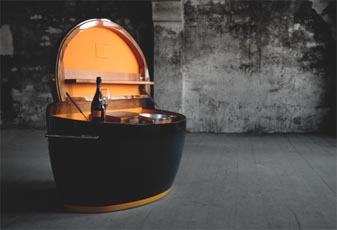Celebrating Veuve Clicquot Ponsardin’s 2009 Grape Harvest

Like Miami during Art Basel or Milan during Fashion Week, the town of Reims, France was buzzing with activity during its most important two weeks of the year—the vendange, or grape harvest. Last year Veuve Clicquot invited us to Reims to learn what happens before the vendange (check out our CH video); this year they invited us back (along with our friends from Notcot, Yatzer, Frizzi Frizzi, and Materialiste) to help with the harvest itself.
You probably already know that the method for making Champagne is used around the world, but only sparkling wine made from three varieties of grapes (pinot noir, chardonnary and pinot meunier) grown in France’s Champagne region can be called Champagne. Efforts are being taken to certify the area as a UNESCO-protected region (Saint-Émillion and the Loire Valley are also certified), which will further enhance the cultural, physical and commercial roles the region plays.
Our trip included visits to many of Veuve Clicquot’s facilities and vineyards, including its beautifully renovated Hótel du Marc, (below). The 1840 manor has been part of Veuve Clicquot’s heritage for more than a hundred years, and is among the first of its age to be completely overhauled with 21st century environmentally-friendly systems. We also toured the cellars and a pressing center.
On a perfect Sunday morning we woke up early and headed to the Manoir de Verzy, which overlooks one of the more than 400 vineyards owned by Veuve Clicquot. This grand cru vineyard is where grapes for La Grande Dame are grown. After picking the grapes we went to the nearby pressing center, where we watched our grapes be pressed. The juice of grapes from each variety and field is stored separately in steel vats, where it goes through its first round of (malolactic) fermentation.
When the wines are ready they are blended by the cellar master and his team to craft the various Champagnes the house produces. If it’s a good year—and from what we learned, 2009 looks to be a very good year—some of the wine is blended only with other wine from the same year, with hopes of making a vintage Champagne. Some of the wine is always reserved to be used for blending in years to come, further ensuring the flexibility to maintain consistency. Rose wine is made at this stage by blending in red wine from Veuve Clicquot’s own grand cru wine from its Bouzy vineyards.
Once blended the wine is poured into bottles and sugar and yeast are added to start the secondary fermentation. Bottle caps are put on, and the wine is put in the cellar to age. Fermentation, over time, creates the carbonation. During this period the bottles are gently turned and angled downward, fractions at a time. At one time this was only done by hand, but today some of the work is done by machine. This process, known as remuage was forever changed by one of Madame Clicquot’s inventions—the remuage table (see below). During this time the yeast is gradually forced into the neck of the bottle, where it remains until it is decided that the Champagne is ready.
When the cellar master decides that the Champagne is ready to be shipped, the bottles are disgorged—they are quickly opened, and the pressure from the fermentation spits out the yeast and sediment. The Champagne is then dosed with sweetened liquer de dosage, made from the Champagne and sugar, which creates the type of Champagne that will be sold, Brut, Extra-Brut, Sec, Demi Sec, or Doux. The bottles are then corked, labeled, packed and brought to a warehouse, where they will settle for two months before being shipped and enjoyed the world over.












